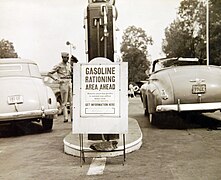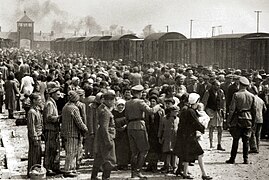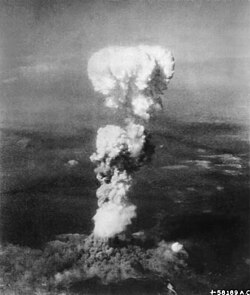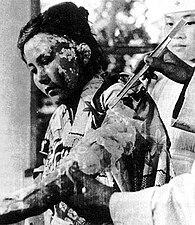US History/World War II and Rise of Atomic Age
Conflict in Europe
[edit | edit source]Formation of the Third Reich
[edit | edit source]
In 1933, German president Paul von Hindenberg named Adolf Hitler chancellor.[2] As Civil Liberties began being limited, and the Nazification of Germany began in earnest, the Weimar Republic collapsed and the "Third Reich" began (in German, Großdeutsches Reich).[3][4] Hitler had outlined his aims years earlier, in his book Mein Kampf(My Struggle).[5] Hitler claimed that Germany had lost its powerful economy, morality, raw materials, land, and resources needed to help it develop as a nation. [5] Hitler blamed "sub-human" peoples such as the Jews for his country's defeat. The superior German people needed "living room," and had a right to claim it. The book called for the elimination of the Jews, and the elimination of homosexuals, the mentally ill, and other "undesirable" elements of German society. Hitler also used this supposed German superiority, as well as German mistreatment by its victors after World War I, to justify the termination of the Treaty of Versailles.
Military Buildup
[edit | edit source]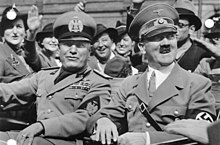
Hitler began a buildup of the German military. In 1936, he tested German might by supporting the Fascists and German interests during the Spanish Civil War.[6] Then Hitler and Benito Mussolini, the Fascist Dictator of Italy, created a coalition with the dictatorship which had come to power in Japan. The coalition of these three nations later came to be called the Axis.
Appeasement policy
[edit | edit source]Many of the borders drawn up in the wake of Versailles were fragile. There were German nationalists in many other countries, including the post-war nation of Czechs and Slavs known as Czechoslovakia. In 1938, Hitler used alleged mistreatment of a German minority in another German-speaking nation to annex or take over Austria. Other nations were reluctant to interfere because of Hitler's claim that the relation between Germany and Austria was an internal German concern which had nothing to do with the rest of Europe. Then Hitler took control of a section of Czechoslovakia partially populated by Germans. This time, British Prime Minister Neville Chamberlain did interfere. In the wee hours of September 30, 1938, Chamberlain and Hitler signed an agreement ensuring that Germany would keep the territory it called the Sudetenland, but would go no further in the country, nor take any German-populated areas in other European nations. The policy which sought to prevent another World War at almost any cost, including the cost of allowing a tyrant to gain more power, became known as appeasement.
Chamberlain called the Munich Agreement "Peace in our time." Hitler had no intention of keeping his word. In 1939, he took over the remainder of Czechoslovakia and demanded Poland. Great Britain and France agreed to come to Poland's aid. Then Germany signed another agreement with the Soviet Union, the confederation of Russia and its supporters under a Communist government. The Nazi-Soviet Pact was an agreement that the two nations would not fight each other. Both countries agreed to take parts of Poland, the Soviet Union securing the Baltic Sea port cities. (It had been a long-term interest of the Soviets to gain ice-free ports for winter trade.) Yet in private, Hitler was already planning to take the Soviet Union over in its turn.
The Beginning of the War
[edit | edit source]Blitzkrieg
[edit | edit source]On the first day of September, 1939, Germany declared war on Poland. The British and French responded by declaring war on Germany two days later.
The Germans used the tactic of Blitzkrieg ("lightning war") in Poland to defeat the Polish Army in as little as sixteen days as the British and French sat back in fear of a new World War. With little warning and no provocation, the German Air Force strafed Poland with top-speed planes and sent in tanks and racing artillery on the ground. The Polish had had no time to build the deep trenches seen in the First World War; the Germans had no need to use mustard gas. By the end of the first week of October, the Germans had gained control of half of Poland. The Soviets invaded from the East. With no time to defend themselves, the last Polish troops surrendered in early October.
In the spring of 1940, Hitler attacked the nations of Denmark and Norway. Denmark surrendered, but British and French troops came to Norway's aid.
Germany entered Belgium and the Netherlands on May Tenth, 1940. The Netherlands surrendered on May 15, though the province of Zeeland held out until the 18th. Belgium was overcome on May 28. On the same day, France recalled its troops from Norway, leaving Norway's fate to Germany.
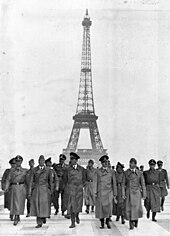
On June Fifth the Germans began their attack on France. To make matters worse, Mussolini declared war on France and Britain on June 10. The French government, meanwhile was taken over by a new Premier, who signed an armistice with Germany on June 17. Germany gained control of the northern part of France, and the Vichy French Government (so called because of the new French capital at Vichy) retained the south. The Italians had a small zone of occupation near the Franco-Italian border.
Battle of Britain
[edit | edit source]Hitler's Germany was the supreme power on Continental Europe. Only the United Kingdom offered resistance. The Germans intended to invade the United Kingdom, but they first had to contend with the British Royal Air Force. The German Luftwaffe (Air Force) commenced the Battle of Britain in 1940. However, the British used the new technology of radar (Radio Detection and Ranging) to combat the Germans. In September, 1940, the Germans ended the Battle of Britain by indefinitely delaying all plans for invasion. Nonetheless, German airplanes continued to bomb several British cities until the middle of the next year.
Invading the Balkans
[edit | edit source]Hitler expanded the Axis in the winter of 1940-1941 with the additions of Hungary, Romania, and Bulgaria. In April, 1941, Germany and Italy then attacked Yugoslavia, which surrendered within one week of invasion. Then Hitler and Mussolini turned to Greece, which collapsed by the end of April. By the end of 1942, most of Europe was under control of the Nazis or the Italians.
Lend-Lease Act
[edit | edit source]In early 1941, the United States abandoned its neutrality and began to aid the British. The Lend-Lease Act allowed the President to lend or lease weapons worth over seven billion dollars to other nations. The first two years of the war overseas saw the American public broadly divided on the issue of potential involvement. Though the danger posed by Germany and Japan was generally recognized, millions of Americans felt that a strong, armed neutrality and oceanic defense without entering the war was the safest course. In contrast, President Roosevelt made it quite clear to those around him that he felt the United States would have to intervene on the Allied side, and planned and acted accordingly, initiating a war industrial buildup and proposing that the US become the "Arsenal of Democracy," supplying ammunition to Great Britain and its Allies.
Conflict in the Pacific
[edit | edit source]Growing Tensions
[edit | edit source]
On June 22, 1941, the Germans invaded the Soviet Union. The Pact between the two nations was dissolved, and the latter joined the Western Allies. Americans were very reluctant to start any conflict with Germany. Even in the fall of 1941, when shooting took place in the Atlantic between German U-boats and US ships, Roosevelt avoided escalation. After this, however, momentous events in the Pacific plunged the Americans into the war.
The Great Depression had affected Japan as much as it had the Western powers. In 1931 a group of Japanese nationalists had assassinated the current Prime Minister of Japan, leading to a military dictatorship. In the same year Japan invaded the Chinese province of Manchuria. Although the government talked of nurturing international friendship, this was a take-over of Chinese national resources. In 1940 the Japanese marched into Indochina (present-day Southeast Asia), which had formerly belonged to the Dutch and to Vichy France. They now commanded the plantations responsible for the world's supply of rubber. The United States retaliated by attempting to prevent Japanese purchases of oil and steel. Tensions between Japan and the United States grew.
A Date which will live in infamy
[edit | edit source]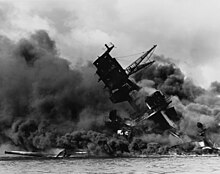
To secure resources and sea lanes for the Japanese islands, the Empire of Japan desired to neutralize the American Pacific Fleet, which was stationed at Pearl Harbor in Hawaii. On December Seven, 1941, the Japanese Air Force bombed the large American naval base, destroying or severely damaging over nineteen ships and 292 aircraft. The US Naval aircraft carriers, huge ships serving as mobile bases for airplanes, were then at sea and survived the attack. Yet its results were still dire: 2,403 American soldiers, sailors, and civilians were killed in the unprovoked strike. Japan made simultaneous strikes on Guam, Midway, and British bases. The next day, the United States Congress declared war on Japan, prompting Germany and Italy to in turn declare war on the United States.
Japan continued with its Pacific operations by taking the American colonies of the Philippines, Guam, and Wake Island; the British colonies of Burma, Singapore, Malaya, and Borneo; and the Dutch colonies in the East Indies.
Battle of Midway
[edit | edit source]An emboldened Japanese navy blundered in June of 1942, attacking Midway Island in the Pacific. After several days of aerial attacks on naval ships, American carrier-based planes defeated the Japanese ships so badly that their navy never recovered. Starving and weakened by disease, they held on for another month before surrendering.
The Home Front
[edit | edit source]With the mass media of motion pictures and the radio, the American government was able to motivate and move individuals and groups more efficiently than ever before. The government had begun to draft eligible young men in 1940, and the draft was ramped up after Pearl Harbor. There was scattered opposition to this overwhelmingly popular measure among religious pacifists and the Nation of Islam, and among the American Communists until Germany attacked the Soviet Union. Under the streamlined system put in process during 1942, males eighteen years of age and older registered with the government. If the individual's name was drawn during an intermittent lottery, he received a postcard telling him to report to his local draft board, organized by the national Subscription Service.[7] (In addition, many men, and some women, signed up without receiving a notice.) At the draft board men walked through the rooms of various doctors, psychiatrists, and military and civil authorities. An applicant could be refused if he was ill, even with such minor ailments as nearsightedness or flat feet. He might also apply for an exemption if he was the head of a family or in a steel or arms factory. There were also exemptions for pacifism, though the man had to have a letter from his priest or minister saying that he had a religious basis for his pacifism. Quakers and Seventh Day Adventists were both denominations known for non-violence. Conscientious objectors could become medics or work in some other peaceful operation in support of the war. Men who had no letter, and who were unwilling to support the War in peaceful ways, were often put in prison and derided by the public. From the draft board men went straight into Basic Training, from there to become soldiers, sailors or Marines, or airplane pilots. Women could become nurses or join various auxiliary forces such as the Woman's Army Corps (WACs). These were not permitted to fight, but in their capacity as communication and supervisory aides were often on the battlefield.
With many men being shipped overseas to fight in the war, many employment opportunities opened up for women. Thousands of women began to support the war efforts by getting employed in many different factories producing tanks and planes and other sorts of weaponry. Some factories which had been devoted to peacetime production of cars and bicycles were converted to armament factories, and the nascent television stations were shut down. Sales of these items were halted "for the duration." The start of World War II brought the end of the Great Depression due to the supplies and men it takes to win a war.
Part of the war effort was the incorporation of American civilians into efforts showing that they could also make a difference. Victory Gardens were even more abundant than in World War I. These supplemented food and gasoline rations, initiated with the aim of getting supplies to the troops. Public work sites, and even some schools and Boy and Girl Scouts, vied to round up paper, scrap metal, and other supplies. These scrap drives brought in a limited amount of useful material, but helped involve some people who would have felt useless in the big war drive. Some public citizens who had not been permitted to join the military were delegated as air raid wardens, making sure that homes were darkened at night. (Especially during the first few years of the war, there was a real fear that some enemy Axis plane might bomb the American mainland.) Hollywood, still reeling from the Depression, brought itself back with instructional films for the troops and propaganda for moviegoers at home.
-
Precious resources such as food and gasoline had to be rationed.
-
Detroit in 1942, a major industrial city that aided the war effort.
-
Workers assemble B-25 aircraft in Kansas City.
-
Women working to build aircraft during WWII.
-
A woman works on an aircraft in 1943.
Japanese-Americans during WWII
[edit | edit source]In February 1942, the War Relocation Authority began to establish centers where Japanese-Americans, including those born in the United States and other citizens, were interned. Though this racial discrimination violated constitutional due process requirements, the Supreme Court ruled that such internment was lawful in 1944, when it decided Korematsu v. United States.
One potential factor in the decision to intern Japanese Americans was the results of the Niihau incident, where a few Japanese-Americans living on a Hawaiian island aided a downed Japanese pilot. Despite this, the vast majority of Japanese-American citizens, many of whom had never left America and grew up in America, were loyal to America. Additionally relatively few Japanese-Americans on Hawaii actually endured internment due to protests of local leaders on Hawaii that internment would cripple the economy of the islands.
-
Many Japanese Americans were forced to close their businesses and go into internment.
-
The Mochida's, a normal family, await internment.
-
A dust storm hits an assembly center. Harsh conditions like this were common.
-
A recreation of one of the barracks at Manzanar. Internment camps offered minimal comforts.

Some Japanese Americans were allowed to leave the camps to study or work. The 442nd Infantry Regiment was composed almost entirely of second generation Japanese-Americans with family in the internment camps, yet they served with distinction in the European Theater, becoming one of the most decorated units in American history relative to it's size and service length. Their actions were responsible for saving the Lost Battalion, American troops trapped behind German lines.
Turning back the European Axis
[edit | edit source]During the summer and fall of 1941, the Germans kept up their amazing pace into the heart of Russia. By December they had reached Moscow, and Leningrad was under siege. The Soviets sent in reserve troops from Siberia, and launched a counter attack. It succeeded, and Moscow was saved.
In the spring of 1942, Hitler ordered an attack into the Caucus Mountains, and Stalingrad. As they had done before, the Germans quickly advanced, breaking through the Russian lines. In Stalingrad, there was street to street, and house to house fighting. The Germans controlled over 90% of the city, but the Russians refused to surrender. A Russian reserve division encircled the Germans into the city, and 250,000 German soldiers were captured. It was one of the bloodiest battles in history.
In 1943, the President of the United States for an unprecedented third term, Franklin D. Roosevelt, and the Prime Minister of the United Kingdom, Winston Churchill held a Conference at Casablanca. The two nations then set up a plan of action for the next stages of the war. Meanwhile, the Russians continued to hold back the Germans, inflicting a crucial and massive defeat on Hitler's armies at the battle of Stalingrad in the winter of 1942-43. After a further major Russian victory at Kursk the following summer, the Germans were forced into retreat back towards Europe.

In Africa, Axis troops led by Erwin Rommel had pushed into Egypt, just 70 miles west of Alexandria. However, British troops led by General Montgomery decisively defeated the Italian and German troops at the Battle of El Alamein. They were pushed out of Egypt, all the way across Libya, and into Tunisia. In November 1942, the Americans launched operation Torch and drove the French troops out of Algeria and Morrocco. After a long battle with Axis troops in Tunisia, they were driven out of Africa in May 1943.
The Allies then decided to invade Sicily, in hope of knocking Italy out of the war. In early July the invasion began. For the next month, the British and Americans led a bloody campaign in which Sicily was finally taken in early August. During the invasion Mussolini was overthrown and arrested. Hitler had him rescued and put him in charge of the new Italian Social Republic. Following the Invasion of mainland Italy in early September, the Italian government signed an armistice with the Allies. The fall of Italy signaled the beginning of the end of World War II. However, Mussolini was rescued by the Germans and had established an Italian Social Republic. Near the end of the War, Germany tries to fight for a last stand with the Allies. It became to be Germany's only hope for turning the war around. The battle took place in a 60 mile deep 40 mile wide "Bulge". Therefore giving the name of the battle, battle of the Bulge. After weeks of fighting in the cold winters the Allied forces came out victorious. Months after this battle the Allied forces had the Germans pushed all the way back into Berlin.
Antisemitism and The Holocaust
[edit | edit source]The prejudice of racism in America -- though the term racist is a misnomer: we are all members of the human race -- was evident from the days of Christopher Columbus onward. Antisemitism was a powerful motivating force in American history. The limits on immigration set in the early 1920s was in part a reaction against [Jewish] immigrants from Eastern Europe. The prosecutors of "Red Summer" had a dread of Blacks, Jews, and atheists, and sometimes of a nightmare conglomeration of all three.
But some antisemitism was an alien import. The Protocols of the Elders of Zion (Russian: "Протоколы сионских мудрецов", or "Сионские протоколы", see also other titles) is an antisemitic and anti-Zionist plagiarism and literary hoax first published in 1903 in Russian, in Znamya; it alleges a Jewish and Masonic plot to achieve world domination. A translation, taken as the literal truth, was published and popularized by the American industrialist Henry Ford. In the 1930s, the American Bund attempted to increase Nazi German influence, and to amplify the antisemitic messages coming from Berlin.
President Roosevelt treated the topic with care. Ethnographers and other scientific experts were drafted into the War effort, emphasizing that Americans came from every ethnic background. Jews were in every branch of the service, and rabbis were among the chaplains brought to aid them. But what came to be known as The Final Solution -- Hitler's plan to eliminate what Mein Kampf had called "the Jewish Question" -- was unknown to the American public. American newspapers had printed accounts of German oppression of its Jewish citizens, from Kristallnacht in 1938 onward. They had occasionally mentioned persecution of its Gypsies, Slavs, and other "non-Aryans," and the dreadful punishments meted out to those who opposed the Nazi regime.
In January, 1945, Soviet troops liberated Auschwitz, the largest of the Nazi Concentration Camps. On April Eleventh, 1945, Allies liberated the Death Camp at Buchenwald, near Weimar, Germany. On the 12th, several journalists arrived, including Edward R. Murrow, one of the most lauded journalists of the time. He sent out a broadcast for American audiences on the Fifteenth describing what he had seen and heard. "There surged around me an evil-smelling stink, men and boys reached out to touch me. They were in rags and the remnants of uniforms. Death already had marked many of them, but they were smiling with their eyes. I looked out over the mass of men to the green fields beyond, where well-fed Germans were ploughing..."[8] On May third, Americans first saw newsreels of the camp. (Newsreels, film of weekly news reports shown in movie theaters, were major sources of information in the days before TV became popularized.) There they heard that the recent death rate had been about two hundred a day. They saw people in the last stages of malnutrition, disease, and "constant hard work, beatings, and torture." The camera also showed corpses of men stacked like cords of wood, and the crematoria where the dead had been burnt.[9]
Now for the first time the majority of Americans could guess at the extent of The Holocaust, one of the most ghastly episodes in the modern history of mankind. In April of 1933, three months after Hitler took power, the Nazis issued a decree ordering the compulsory retirement of "non-Aryans" from the civil service. This is known as the spark of the Holocaust. Before Germany was defeated, there were some eleven million people that had been slaughtered in the name of Nazi racial purity. Although the Jews were the favored targets and are the victims we most hear about when talking about the Holocaust, they were not the only victims. There were also millions of Russians, Poles, gypsies and others that were also murdered. Although the deprivation of the Jews started in the years following 1933, the mass killings didn't begin until 1941.[10]
The effect of this knowledge was augmented by the Nuremburg trials of 1945-1946. There many German officials, and some Concentration Camp governors, were put to trial for committing these murders, called crimes against humanity. American antisemitism has continued since that time, but it is at least officially frowned upon. The American eugenics movement also suffered a setback from which it has not yet recovered.
-
Kristallnacht (The Night of Broken Glass) aftermath in November 1938. Here Jewish shops were looted. Other buildings connected to Jewish residents, including Synagogs were also targeted.
-
Jews in Nazi occupied areas were required to identify themselves by wearing clothing marked with a yellow Star of David, making it easier for Nazis to discriminate against them.
-
Auschwitz II-Birkenau in 1944. The Inhumane treatment of holocaust victims played a major role in how human rights are considered, as well as in the Nuremberg trials following the war.
-
Aerial photo of Auschwitz in 1944. The horrific scale of the Holocaust is hard to picture - This is just one of many concentration camps.
-
Bodies being burned, following killings in Gas Chambers.
-
The Judges panel at the Nuremberg trials, where Nazi officials involved in the Holocaust were put on trial following the war.
-
Auschwitz I in 2010, a symbol of a dark chapter in history.
Operation Overlord
[edit | edit source]
In November, 1943, Prime Minister Churchill and President Roosevelt held another Conference at Tehran. Joseph Stalin, who held the title of General Secretary of the Communist Party of the USSR, but was actually a Dictator of the Soviet Union, joined them there. The three leaders agreed to a plan codenamed Operation Overlord, under which an attack would be launched on the northern coast of France from the English Channel. In preparation for an invasion of France, Hitler cut off all support for the German armies remaining in the Soviet Union. Thus disabled, the German Army was forced to withdraw from Russia in the winter of 1943-1944.
On June 6, 1944 ("D-Day,") in the early morning hours, American and British paratroopers were dropped into Normandy. Hours later, American, British, French and Canadian soldiers landed at Normandy on the north coast of France. The troops landed near Caen, but Hitler wrongly felt that they would attack at a location to the north of that city. The Allies took advantage of Hitler's miscalculation; by the end of the month, the Allies had over eight hundred thousand soldiers in Normandy.
Meanwhile, Russian troops, which had been on the defensive, began their offensive on German-controlled territories. In the middle of July, the Soviets won their first major victory by taking the territory of Belorussia. At this time, concern began to grow in the West about Soviet domination replacing German in eastern Europe, especially in Poland. Despite these worries, Roosevelt felt that he had little influence in that area over Stalin, whose armies were bearing a huge brunt of the fight.
By the end of July, the Allies expanded their base at Normandy by breaking out into the rest of France. Pushing through the nation, the Allies had gone far enough to liberate the city of Paris on August 25. On September 11, some Allied troops entered Germany, taking Antwerp, Belgium on the way. German resistance then hardened, however. British Field Marshall Montgomery attempt to "end the war by '44" with Operation Market Garden, a plan to liberate Holland and bypass the German border defenses, failed. The British and American armies would make little more progress for the rest of 1944.
Meanwhile, Russian troops pushed toward Germany, defeating Germany's Axis partners on the way. In August, Romania surrendered, followed by Bulgaria and Finland in September.
Yalta and German Surrender
[edit | edit source]German Counteroffensive
[edit | edit source]Allied air bombing of German industries and cities had been ongoing and savage since 1943, but did not have the intended effect of crushing the German will to fight. Indeed, Hitler was able to field new advanced weapons in 1943-45, such as the world's first jet fighter aircraft, the V-1 flying bomb, the V-2 ballistic missile, and new types of tanks and submarines. The new weapons, however, proved of little use against Allied numbers and economic superiority, with American industrial production for the war effort massive and untouched by Axis attack. Germany forced millions of prisoners into slave labor, under the most brutal conditions, to keep its own war effort going.
In December 1944, Germany launched a massive counter-attack on the light defended American positions in Belgium. The Germans hoped to cut off the Allied supply lines, however, after reinforcements arrived, the "Bulge"(today it is know as the Battle of the Bulge) was flattened out. Meanwhile, the Soviets were on the verge of entering Germany from the east en masse, having taken control of Poland. Hitler's troops were exhausted, millions dead or captured, and with the fall of the Romanian oil fields, German armies were running out of gasoline. A final call-up began of old men and boys for a last-ditch defense of Germany. Many German civilians fled, fearing the revenge the Russians would put on them after what the Germans had done in Russia. Thousands of German noncombatants were raped, and many of these were then killed.
The Yalta Conference
[edit | edit source]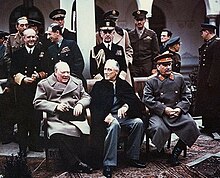
In early February 1945, United States President Franklin D. Roosevelt, British Prime Minister Winston Churchill, and Soviet leader Josef Stalin, the three leaders of the anti-Nazi alliance, met at Yalta in the U.S.S.R.[11] The leaders of the Allied powers, "The Big Three," were planning for the end of the war. This was a follow-up to the meeting of the three powers in November 1943 in the Tehran Conference.
At Yalta the countries contended on what to do with Germany. Churchill and Britain wanted to protect their colonial possessions and to keep the Soviet Union from having too much power. Stalin and the Soviet Union wanted Germany to pay them to help start the rebuilding of their country. Stalingrad, a byword for Soviet military resistance of Hitler, was now in ruins. Two wars of German aggression had been too much, and the country needed to be permanently restrained. The United States wanted to influence Germany toward democracy and to keep the peace.[12] The Yalta conference decided the division of defeated Germany into zones for reconstruction. The leaders agreed to punish Nazis for war crimes, including the Holocaust. Other topics included Soviet Russia's entry into the war against Japan, composition of the post-war government of Germany, voting arrangements in the new United Nations organizations, and the future of the liberated governments of Eastern Europe.[11] The Yalta Declaration on Liberated Europe, which called for free elections and constitutional liberties in Eastern Europe, was the most controversial topic of the Yalta Conference.[11]
Race to Berlin
[edit | edit source]
The Allies first attempted to reach the Rhine River in their quest to take over Germany. In March, this goal accomplished, the Americans and British opposed the Soviets in the Race for Berlin. The Race determined who would control Berlin, a city that would prove important in the reconstruction of Germany. The Americans allowed the Soviets to win the Race for Berlin. Fierce fighting erupted in and around the city as motley German units made their last stand against the powerful army groups of Russian marshals Zhukov and Koniev. His capital surrounded and his loyal minions deserting him, Adolf Hitler committed suicide in his Berlin command bunker on April 30, 1945. Benito Mussolini was executed by Italian Partisans on April 28. The new leader of Germany, Karl Doenitz, agreed to surrender. On May 8, Germany formally signed an unconditional surrender, dissolving the Axis and leaving only Japan to be defeated.
The End of the FDR Era
[edit | edit source]
The public was never informed of the extent of President Roosevelt's paralysis. Though he admitted that he had suffered polio, no newsreels showed him pulling himself along with his crutches. At press conferences the photographers were led in when he was already in a chair or in his car seat. Compensation for the leg disability, and the physical activity the Roosevelts were known for, had made his upper arms strong and muscular. However, his physical strain combined with the burden of the Presidency to weary him. Speaking to Congress in the wake of Yalta, he made a rare admission of how much this affected him: "I hope that you will pardon me for this unusual posture of sitting down during the presentation of what I want to say, but . . . it makes it a lot easier for me not to have to carry about ten pounds of steel around on the bottom of my legs; and also . . . I have just completed a fourteen-thousand-mile trip."[13]
Roosevelt was ill, and had been frail even before his re-election in 1944. The Republican party had objected to the President even running for a fourth term. The Republican Candidate, Thomas E. Dewey, accused him of running a corrupt autocracy and of feigning good health. In response to accusations of corruption, Roosevelt dropped former Vice President Henry A. Wallace and picked up newcomer Harry S. Truman, who had risen in a War anti-fraud committee in the Senate. He also campaigned vigorously in the cities, which may have hastened his death.
Roosevelt died of a stroke on April 12th, 1945. After FDR's death Harry Truman became president. The day after Roosevelt's death Truman sought out old friends to ask for their help in this "terrible job."
The Atomic Bomb and the End of World War II
[edit | edit source]Island Hopping & Kamikaze
[edit | edit source]After the Battle of Midway the United States surely retook the Asian Pacific nations, fighting the Japanese empire island by island, by gun, by shell, and by flame thrower. Though the Japanese continued to fight, its armed forces were in a hopeless situation. Its armaments became fewer. Kamikaze (the Japanese word for "Sacred Wind"), pilots who hoped to destroy American ships by intentionally crashing their own planes into them, became more dominant in Japanese opposition.
The Manhattan Project
[edit | edit source]
The United States had become involved in a competition with Nazi Germany to find technologies which would win the war. Among these technologies was nuclear fission, the splitting of a highly electronegative atom into smaller ones, which gives off ten times as much power. With cooperative or captive scientists and slave labor, the Nazis were attempting to use uranium to create an atomic bomb. During the same time, America had become the home for dissident German and Jewish scientists. Native-born and newly-emigrated American physicists were also talking about the possibilities of fission. One of the latter, Albert Einstein, sent a letter to President Roosevelt in 1939 explaining the developments in the nuclear chain reactions which would result in an atomic explosion.[10]
In 1942, a number of the top minds in physics were relocated to a secret location in New Mexico. These men volunteered to work at what was code-named the Manhattan Project, a secret attempt to bring to fruition what Einstein had posited in 1939. At its height the Manhattan Project employed more than 600,000 workers, the majority of them not realizing what they were really working for. After spending more than two billion dollars, the Project created the first atomic bomb.[10]On July 16, 1945, this bomb was successfully tested in New Mexico.
In the interim, Germany had been defeated. President Roosevelt had died, and had been replaced in office by his Vice President, Harry S. Truman. President Truman listened to experts who forecast two more years of war against Japan, and the prospect of a bloody American invasion. Truman chose to use the atomic bomb instead of an invasion.
Hiroshima and Nagasaki
[edit | edit source]On August sixth, an A-bomb with the name Little Boy was dropped on Hiroshima, Japan, by a B-29 aircraft piloted by Col. Paul Tibbets. The explosion formed a mushroom cloud. Dust and debris shot into the sky and was seen miles away. Many people died instantly, but others fell sick a few days later from effects on the radiation on living tissue. The American press was told about the detonation of the bomb on a population of civilians, but not about its full effects. The Japanese government did not give in. On August ninth a bomb called Fat Man was dropped on the weapon-producing city of Nagasaki, again upon civilians. Together, the bombs killed over one hundred thousand people. Between the two bombings, meanwhile, the Soviet Union had joined in the war on Japan. The Americans threatened a third bombing on Tokyo, though they had not yet had time to create a new bomb. Now Japan unconditionally surrendered, officially ending World War II. Officials signed a treaty for surrender on September 2, 1945, aboard the USS Missouri.
-
The Enola Gay and Crew.
-
Hiroshima prior to bombing.
-
The same area of Hiroshima after bombing.
-
Atomic cloud over Hiroshima.
-
The aftermath of the Atomic Bomb on Hiroshima. The human cost of the bomb was immense. The bomb warped the city into a deadly hellscape, leaving little more than rubble, a few scattered ruins, and radiation once the fires died down.
-
A heavily injured person receives medical treatment.
-
Nagasaki prior to bombing.
-
The same area of Nagasaki after bombing.
-
Atomic cloud over Nagasaki
-
A person carbonized by the blast. Horrific deaths like this were common as a result of the bombing.
Death Toll
[edit | edit source]The death toll of the Second World War was greater than that of the First. At least sixty-one million people died from the Allied nations of the Soviet Union; the United States and its colonies; Great Britain, its colonies and Canada; France and its colonies; the Netherlands and its colonies; Belgium and its colonies; and Poland, Norway, and Greece. In contrast, the main Axis powers of Germany, Italy and Japan only suffered twelve million casualties.
References
[edit | edit source]- ↑ https://www.archives.gov/research/holocaust/finding-aid/civilian/rg-84-germany.html
- ↑ https://www.bbc.co.uk/bitesize/guides/z3bp82p/revision/7
- ↑ https://www.smithsonianmag.com/history/true-story-reichstag-fire-and-nazis-rise-power-180962240/
- ↑ https://libguides.merrimack.edu/CourageToRemember/NaziGermany
- ↑ a b https://history.hanover.edu/courses/excerpts/111hitler.html
- ↑ https://www.archives.gov/research/holocaust/finding-aid/civilian/rg-84-spain.html
- ↑ The Draft and World War II, webpage of the National World War II Museum. Retrieved 11/23/2014 from http://www.nationalww2museum.org/learn/education/for-students/ww2-history/take-a-closer-look/draft-registration-documents.html
- ↑ Murrow, Edward R. Partial transcript of April 16, 1945. The Jewish Virtual Library. Retrieved on 11/16/2014 http://www.jewishvirtuallibrary.org/jsource/Holocaust/murrow.html
- ↑ Buchenwald Nazi Concentration Camp Liberation footage -- stock footage -- www.PublicDomainFootage.com. Retrieved from YouTube, https://www.youtube.com/watch?v=eBITJiR75tg , 11/16/2014.
- ↑ a b c "WWII" by Eric Sevareid
- ↑ a b c Sibley, Katherine A. S. The Cold War. Westport, CT: Greenwood, 1998. Print.
- ↑ A People and A Nation
- ↑ Address to Congress on the Yalta Conference. March 1, 1945. The American Presidency Project, John Woolley and Gerhard Peters, eds. Retrieved 12/27/2014, http://www.presidency.ucsb.edu/ws/?pid=16591

